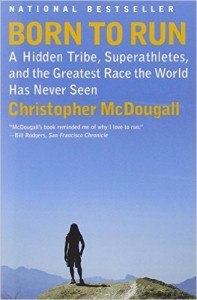Tell a runner they’d get better results lifting weights, and they tell you they’re trying to lose fat not gain muscle. Tell them having more muscle makes you burn more fat, and they tell you they enjoy running. Tell them the ‘runners high’ is experienced faster with HIIT, and they tell you they’re trying to build aerobic capacity. Tell them the aerobic improvements are equivalent, and they tell you “We’re Born to Run.”
Ever since the release of Born to Run, by Christopher McDougall, it’s become standard practice to say we’re genetically programmed to run long distances – as if this book provides undeniable proof that ultra-marathons and triathlons are in our DNA.
Yes, there’s evidence to suggest that infrequent persistent hunting existed in some tribes we descended from, but it’s unrealistic to think that we developed our unique human traits as a result of this behavior. And similarly, that we should be running long distances on a regular basis, competing in marathons and triathlons, and relying on this as our predominant form of exercise.
From Quadruped to Biped
To appreciate some of the evolutionary traits that are unique to Homo sapiens, it’s important to understand why we moved from quadruped (4-legs) to biped (2-legs). It’s still a question that remains unanswered ‘officially’ (and there are over 10 theories on the subject), but the majority of credible evidence appears to point to some sort of transition from jungle to savannah, and an increased need for consistent travel.
The obvious advantage of being on 2-legs is an increased field of vision – either to scout out prey and resources, or for a much-needed warning of approaching predators. And interestingly, this fits into the explanation from Born to Run, that says our slowness is “why we run far.” Though it seems to make a lot more sense to say that our slowness is “why we stand on 2 legs” – as even when we were on 4 legs, we were significantly slower.
The second advantage of bipedalism, is to free-up the arms. Which makes sense when looking at an increased need to carry extra supplies (food, water, and resources) across the scarce savannah.
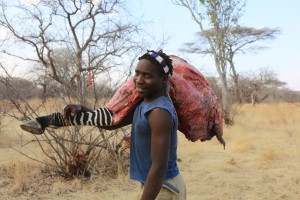
Another thing that’s clear, is that walking efficiency and heat regulation would be important environmental advantages during these long treks. So, it’s not surprising to see that they make up 2 of the popular evolutionary theories explaining the shift to bipedalism – the travel efficiency hypothesis, and the thermoregulatory model.
Marathoners will try to say the superior efficiency of 2 legs for covering long distances means we should be running, but when looking at the transition from quadruped, it’s clear that we gained this genetic adaptation to be better walkers.
Bipedal walking is 75% more efficient than quadruped walking, but quadruped running is more efficient than bipedal running.
Because if we were born to run, wouldn’t it make sense to go back to 4 legs?
The book also tries to take credit for humans unique ability to thermoregulate – even though this trait appears to coincide with the switch to 2 legs. As evolutionary biologist Dr. Peter Wheeler’s explains, bipedalism decreases the body surface that’s close to the hot desert floor, and helps us access cooler winds and release more heat. Compared to a 4-legged creature, it also exposes upright humans to less direct overhead sun exposure.
From Hominid to Human
After the transition to 2-legs, books like Born to Run and their faithful four-minute mile following, would have you believing that the skeleton on the left was formed based on generations of adaptations that can be linked to persistent hunting. Even though it looks a lot more like we continued to improve upon the genetic adaptations that brought us to bipedalism in the first place.
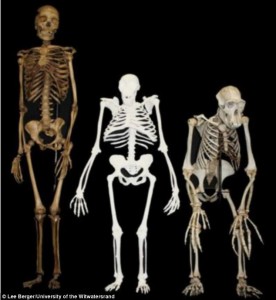
Notably, our advantageous view of the savannah and distance from the hot ground continued to increase, and we grew longer legs (for bigger steps) and smaller arms (for less dead weight) to improve our walking efficiency.
Knowing what we now know about the introduction of meat during this time period, it’s also clear that we continued to trade in our large ape-like gut for a smaller stomach and bigger brain.
Harvard researcher, Daniel Lieberman, is commonly referenced to make connections between persistent running and our adaptation from hominid to human. But when you take an honest look at the evidence, all of his points can be explained by improved thermoregulation, walking efficiency, and the switch to bipedalism in general.
For instance, here’s a list of the characteristics often related to endurance running:
- Spring-like arches and short toes
- Long legs and big glutes
- Large joints in the legs and spine
- A nuchal ligament connecting head to neck
- Lower and wider shoulders that are decoupled from the head,
- Elaboration of sweat glands and loss of body fur
The reason our feet were reshaped is so we can stand and walk better. We traded in our large grasping toes for a bigger weight-bearing heel, and developed an arch to efficiently transfer weight and propel us forward during walking.
Our large supportive hind legs were also designed for standing and walking – as the hips were reshaped to bring the spine closer and make room for the glutes, the knees increased in size for more load bearing potential, and the thighs were turned inwards to position the knees directly under the body. Giving us more stability and differentiating us from the ape that struggles to stand upright for long periods of time.
When walking, the heavy tree-swinging arms are a nuisance, which is why we opted for big glutes to hold us upright and longer legs to propel us forward while walking.
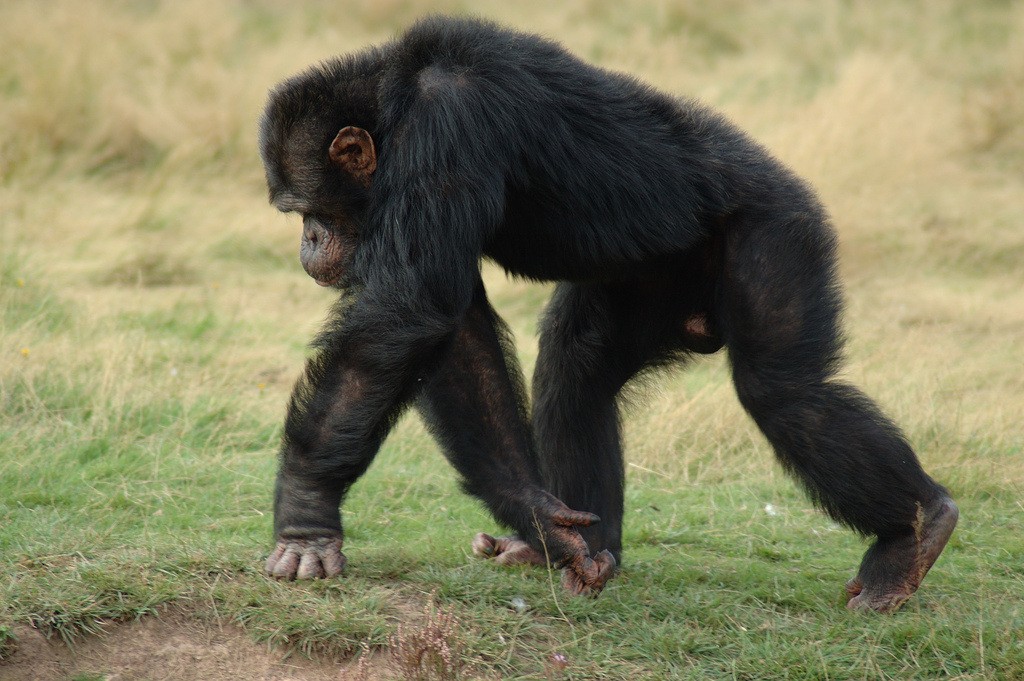
Interestingly, we’re not really designed to use our arms much while walking – as the natural swing of our long legs and push from the ankle means very little muscle activity is necessary from the upper body. Instead, the new human arms are made to carry and manipulate objects with precision.
As for the nuchal ligament (think bobble head), it seems this has more to do with holding up an ever-expanding brain. And sure, it’s not present in mammals that “don’t run,” but it’s also present in mammals that don’t run long distances, like sheep and cows.
We’ve seen these head-balancing adaptations in the neck and spine occurring since the shift to bipedalism. With the foramen magnum (hole in the skull where the spinal cord attaches) moving further underneath the head to transfer more of the weight behind the spine, and a lumbar (lower back) and thoracic (upper back) curve to bring the center of gravity over our feet and prevent a forward lean.

And yes, we CAN run. So, a nuchal ligament would come in handy to balance our ginormous head. But it’s quite far fetched to say this is why we SHOULD run (even if you are a runner).
Lieberman and colleagues research is definitely very interesting, especially when looking at the collision force comparison’s between barefoot and shoe-wearing runners, but it seems they’re trying very hard to attach bipedal advancements to a persistent hunting hypothesis. Even when looking at the loss of body fur, changes in shoulder structure and sweat gland improvements, they can be explained by a shift from a shoulder-stable quadruped to a shoulder-mobile biped, that’s continued to progress in thermoregulation.
The Million Dollar Question
We started standing up approximately 4 million years ago (as Australopithecus) and somewhere between then and now we developed a larger human brain and more intelligent tools to hunt, cook and eat.
The mind-bending fact for scientists, was that it appeared we were acquiring meat and growing our big juicy brains long before we developed the tools. Leading to what seemed to be one of the greatest evolutionary questions:
“How the heck did we get the meat without the tools?”
We’re slow, we don’t have claws, and the beasts we were hunting could definitely out-muscle us. So, how would we get close enough, and what would we do to kill the animal even if we did?
The endurance enthusiasts would tell you we stumbled upon persistent hunting, after realizing that we could out-last these faster animals by chasing them until they tire. With evidence for this theory somewhat supported with the observations of the San People, or Bushman, of the Kalahari desert – one of 14 tribes that humans are said to have evolved from, that still practice this hunting technique today.
So, persistent hunting definitely exists, and we’re more than capable of taking part in it. But does that mean this behavior is what facilitated the transition from a small brain on 2 legs to a big brain on 2 legs? And this hunting technique should get all the credit for introducing meat to the hominin not-yet human?
Because the big-armed, bipedal tree-climber, never would have come across an animal protein source?
Recent evidence from John Hopkins University, published in 2010 in the Proceedings of the National Academy of Sciences, shows that Pliocene hominins were consuming a variety of aquatic animals (turtles, fish, crocodiles) before the appearance of the well-adapted human frame (Homo erectus). While other evidence has shown that even the chimpanzee was scarfing down on meat before the running man came along (1, 2); with some studies suggesting daily intakes of as much as 65g per day in the dry season!
And similar to hominins, they also supplemented whatever protein and fat rich insects they could find.
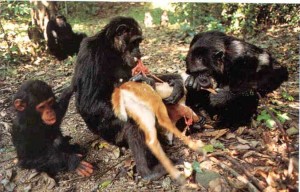
When you think about it, it’s almost insulting to say that we’re incapable of scavenging like a crow – waiting for the predators to leave and picking away at whatever was left on the bones, or grabbing what we could and using our bipedal advantage to carry it to safety for consumption. As even the Neanderthal, that is commonly (but wrongfully) looked at as ‘dumber’ than humans, found a way to hunt for meat without the ability to run. With evidence from 2010 in the Proceedings of the National Academy of Sciences showing that they commonly consumed birds.
But all that being said, the question of how we got meat before tools may not be worth answering to begin with – as more and more research continues to surface that we had tools much earlier than was originally thought. With the first evidence coming in 2003 in the Journal of Human Evolution showing 2.5 million year old tool use, and a recent study from 2010 showing stone tool use in Ethiopia approximately 3.4 million years ago. Suggesting that tools were in our hands before we were human.
“The hominids at this time…had small australopithecine-sized brains, but nevertheless figured out how to cut through often tough hide to efficiently get the meat off the bones and break the bones open for the marrow.” Paleoanthropologist Henry Bunn, 2009
Possible vs Plausible
The biggest knock against the Born to Run Theory is that the earliest members of the Homo group lived in a mixed environment of jungle and savannah. Not only making persistent hunting less of a necessity, but making it less possible. Since trees and roughage would become obstacles and reduce vision.
But for arguments sake, lets pretend persistent hunting helped us access the nutrients that grew our big brains and made humans what they are today. Does this mean it makes sense to use running as our predominant form of exercise, and start training for and running in marathons?
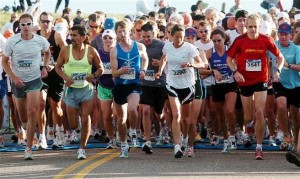
After watching the videos of the Bushman of the Kalahari desert, it’s clear that persistent tracking techniques definitely exist. But they’re slightly different than the ultra-endurance enthusiasts, or the story of the Tarahumara, would have you believing.
For one, it’s usually a single tribesman that engages in the tracking. Plus, it tends to include a lot more walking and watching that it does consistently running at a moderate-intensity pace for miles and miles.
Researchers, Pickering and Bunn, shared observations of persistent hunts by the Hadza in their 2007 paper in the Journal of Human Evolution, and noted ‘relentless walking after the animal’ and ‘forcing it away from shady areas for three hours’ until it was exhausted.
Further, it appears to be a very infrequent occasion. With one large kill feeding a tribe for quite some time, meaning hunts were a couple times a year at most. Implying that a lot of people (mainly women and children) never did any steady-state endurance running, and the men that actually did the hunting maybe did 1 hunt annually – with one every couple years probably being more realistic.
So, even if we forget about whether we’re uniquely designed to do this, it’s clear that the 20 miles a week and 3 marathons a year that’s characteristic of the endurance enthusiasts is nothing like persistent hunting. And if we’re talking about what we’re BORN to do, it’s a mistake to prioritize this extremely rare persistent hunting regimen, while neglecting the activities that used to be a daily occurrence – like walking, climbing, crouching and carrying.

When you think about it, saying “we’re born to run” is kind of like saying “we’re born to starve” – as clearly we are capable of chasing an animal until he tires, or going weeks without food, but that doesn’t mean it’s a requirement.
The early humans understood this – as the first thing they did when they grew a big enough brain, was Stop Jogging! Compared to today, where we have giant brains and try to convince ourselves that it’s a necessity.
How ironic.
Stay Lean!
Coach Mike
RELATED ARTICLES:
Walking is a Man's Best Medicine
Cardio -The Worst Investment Ever?
What Really Happened To Neanderthals?
Intensity = Lift More Weight NOT Lift Weight More
Exercise Intensity Trumps Exercise Duration For Disease Prevention
